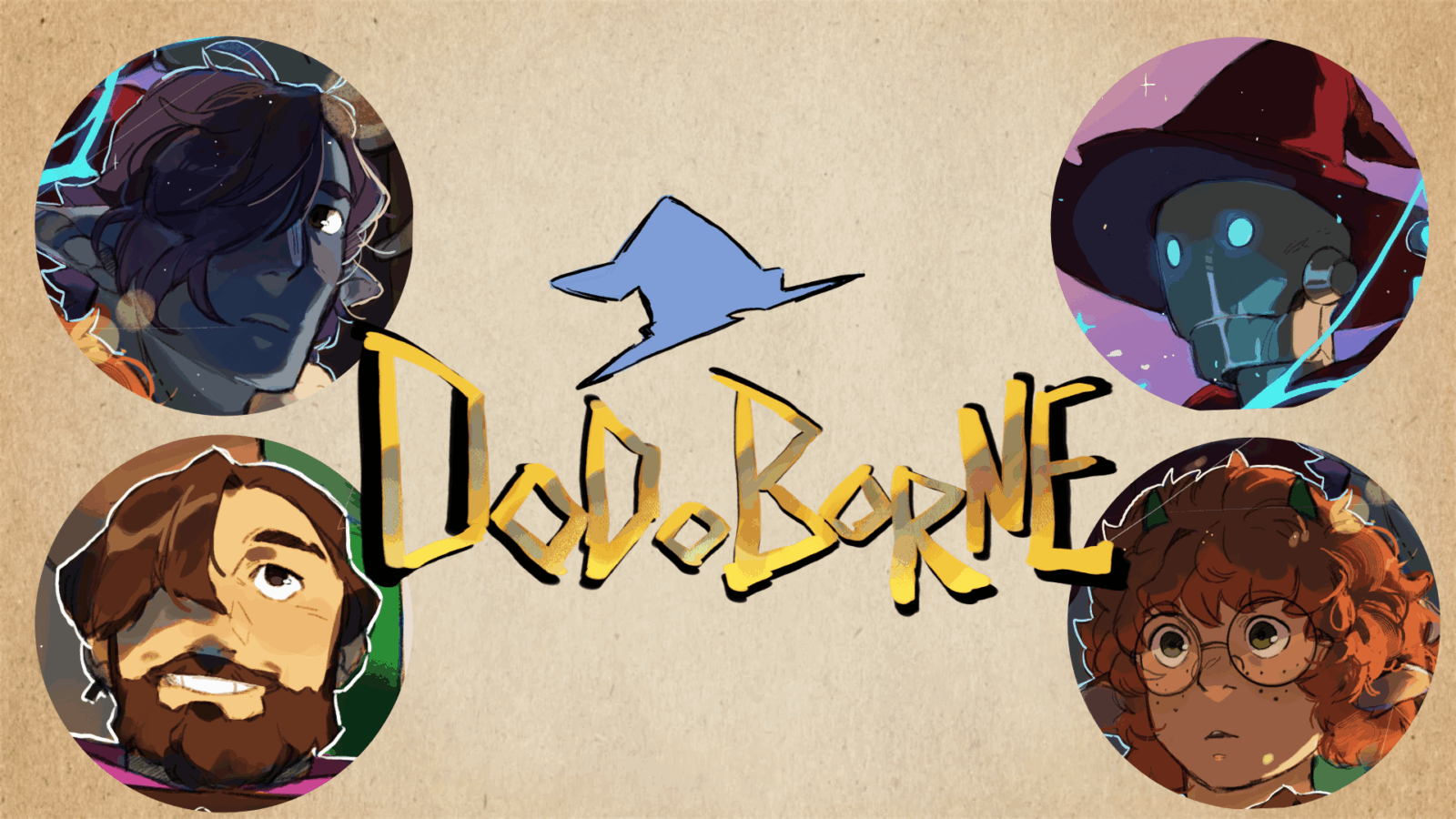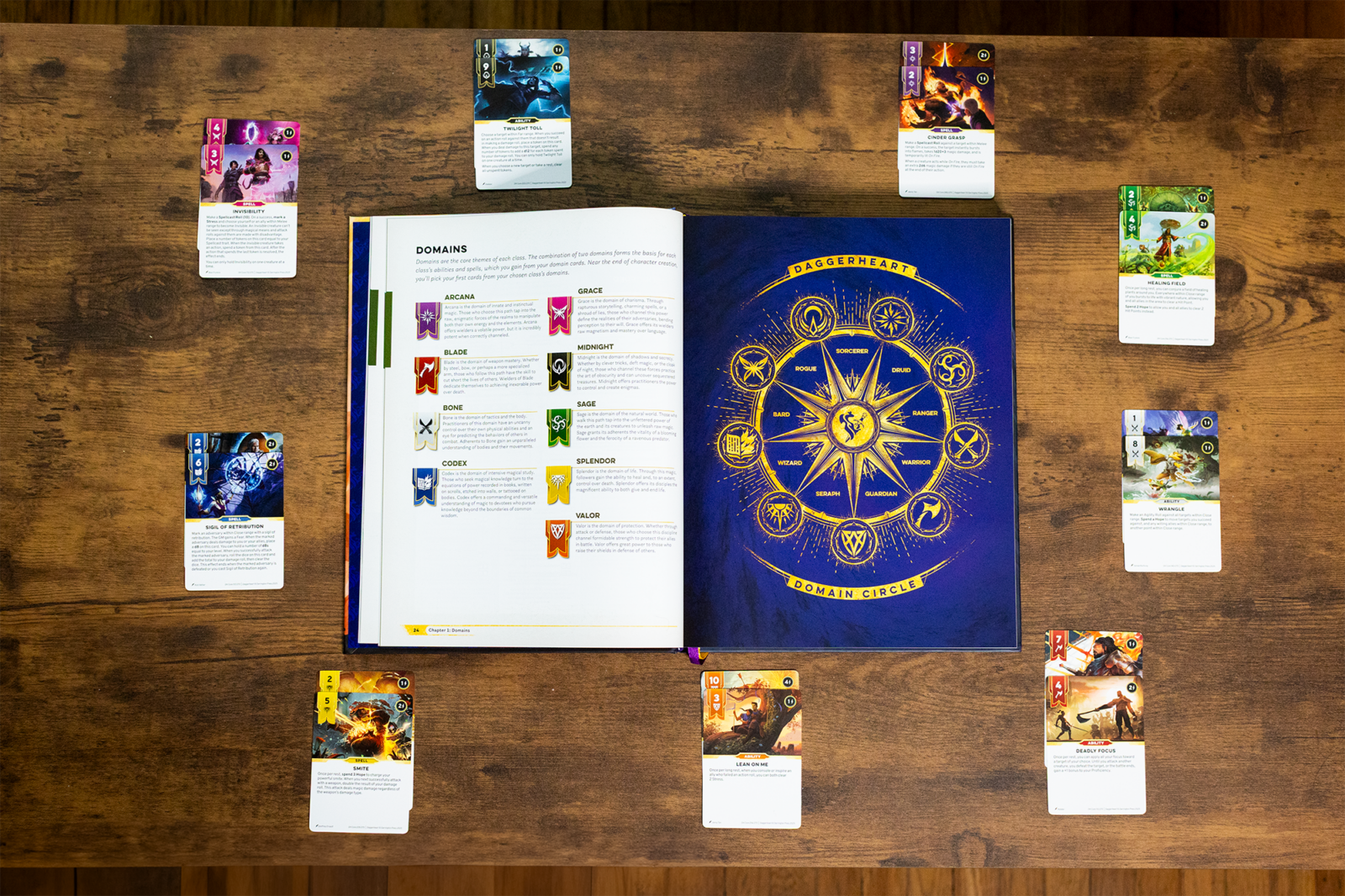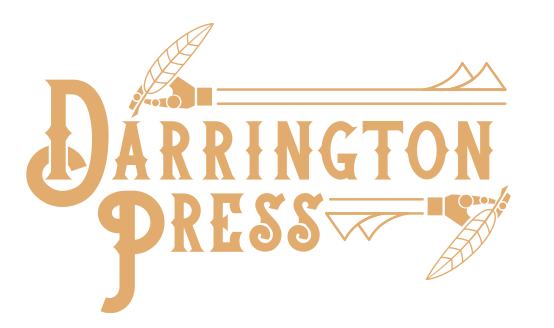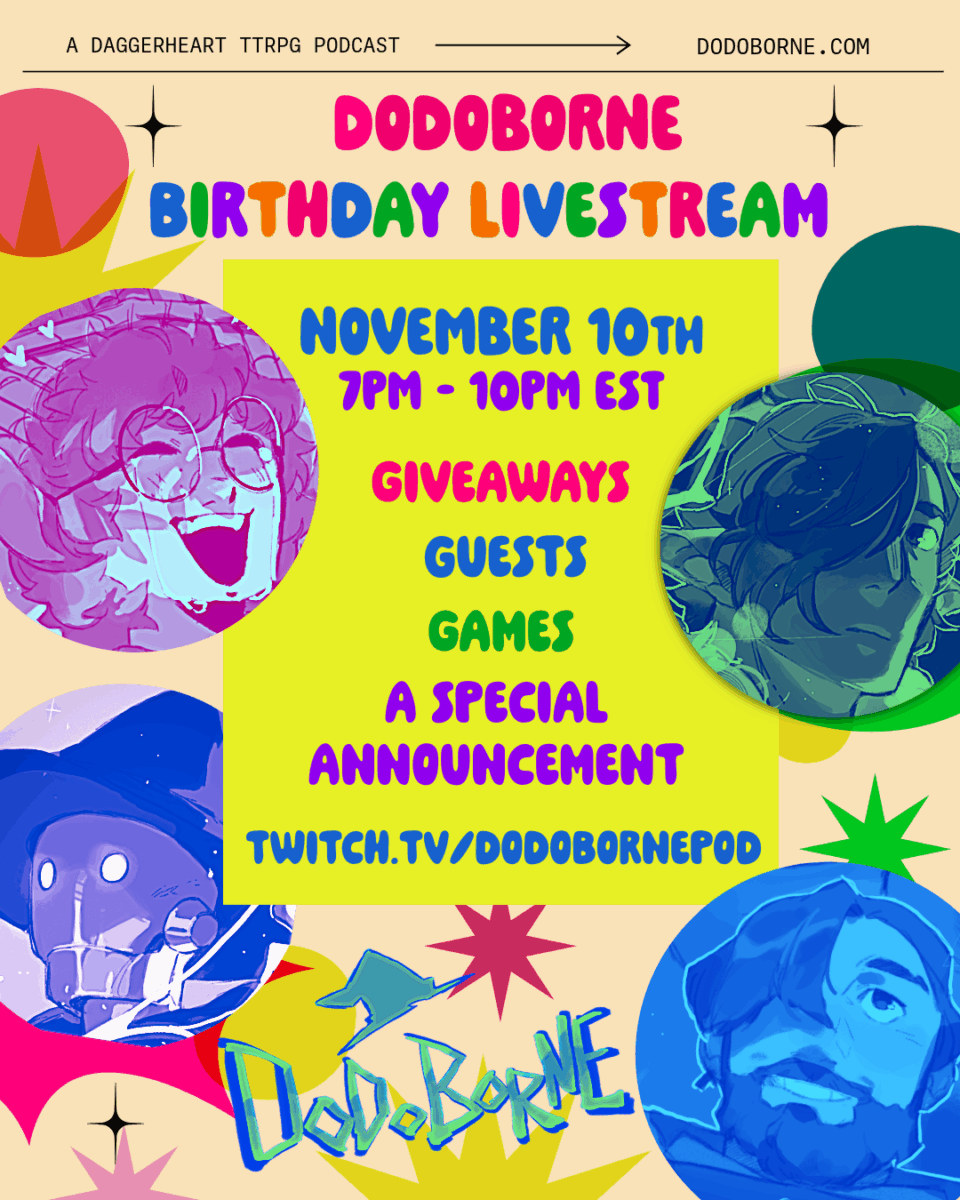- HOME
- PRODUCTS
- A Familiar Problem
- Candela Obscura
- Caper Cards: Bells Hells
- Daggerheart
- For the Queen
- Queen by Midnight
- Queen by Midnight: Quarter Past
- Solar Gardens
- Tal’Dorei Campaign Setting Reborn
- Till the Last Gasp
- Uk’otoa
- Vox Machina Art Books: The Chronicles of Exandria Vol I
- Vox Machina Art Books: The Chronicles of Exandria Vol II
- SHOP
- LOCATE GUILD STORE
- LATEST INFO
- NEWSLETTER
- CONTACT US
So, You’re Thinking of Trying Daggerheart? (With the Creators of Dodoborne)
- Blog
-
Nov 10
- Share post

Dodoborne is an improvised comedy podcast where four friends dive into Daggerheart, the brand-new tabletop roleplaying game from Darrington Press. Dropping every other Tuesday, Dodoborne mixes humor, heart, and a bit of nonsense while bringing the community along for an ever-evolving adventure. Listen to Dodoborne on their website or wherever you get your podcasts!
They’ll also be celebrating one year of Dodoborne with a special birthday livestream today on November 10th starting at 4pm Pacific on Twitch! The stream will include giveaways, guests, and a special announcement, so be to tune in!
With varying degrees of TTRPG experience, we asked the creators of Dodoborne—Isaac, Rowan, and Joe—what they think people should know when trying Daggerheart for the first time. Dive into their in-depth answers below!
Isaac Allen Burns
Hey, it’s me! Your GM, your best friend, and your author of this segment. I’ve been a GM for nearly 10 years and have run a handful of systems, from the ubiquitous D&D, to one-page Laser Feelings, to modern horror Delta Green, and now to Daggerheart. I tend to lean story-first and narrative-heavy in my play style, so keep that context in mind when reading. I’ve got three tips for GM’s looking to run a game of Daggerheart.
So you’re coming from D&D…
Right from the beginning, let’s talk mechanics. I’ve played 5e for a long time, and D&D and Daggerheart have a few nuances that set the gameplay apart. There’s many guides that will go more in depth and talk about full blown conversions, but I want to give you three mechanical rules I repeat to myself before running Daggerheart to get me in the right mindset:
You only roll if an adversary attacks a player. Otherwise, make a player do a reaction roll. My instinct at times is to have an NPC make an opposed check to see if they notice something the players are doing (which you can hear in the first few episodes of the podcast!). That is no longer the case! Action is solely up to the player’s rolls beating the adversary’s difficulty. Which feeds into the next mechanic:
Rolls are a resource. There can’t be any flippant rolling in this game, as most rolls are now giving someone a resource to use. No more group rolls where everyone makes an attempt at something. No more calling for a perception check solely to give yourself more time to think. Due to the nature of each roll having four potential outcomes, anything the players have to roll for should generally have that level of variance in results. Something else to keep in mind is that a failure with fear is the worst possible outcome for them, as there is no such thing as a critical failure here. And finally:
Combat is not a separate form of play. How you GM the game does not change when combat starts. You still spend fear tokens to make things happen, but now you can add “Adversary attacks” onto the list of GM moves you can make. You still ask the party “What do you want to do?” You still keep track of who hasn’t gone in a while. You still give them the spotlight when appropriate. (Of course, the rules support more crunchy, 5ft-square combat).
Now these mechanics are all well and good for getting into the vibe of daggerheart, but I also want to discuss a few additional considerations for you as a GM on how to get the most out of this system. For starters:
Stay Loose and Actively Listen
Have you ever had a conversation with someone where it was obvious they weren’t really listening to you, and were just waiting for a break in your words to steer the conversation elsewhere? It doesn’t feel great. TTRPG’s are like a conversation, and you don’t want one person to dominate that conversation, even if they have the title of Game Master.
Daggerheart emphasizes cooperation and coordination. While the GM holds the levers of narrative control via the Fear mechanic, those levers should be pulled at the behest of the players’ decisions and interests. If the macguffin is at the abbey, but the players won’t stop asking about the love life of the fish monger, then put the macguffin at the fish market. If a player brings up a medallion their mother gave them that has a weird symbol on it, then the macguffin now has that symbol on it. Listen to what your players are bringing up, and react accordingly.
Now if the party stops talking to the fish monger after a while and goes to the abbey, then great! And if your medallion-clad player says “huh weird. Well whatever.” to the macguffin matching their medallion, then that is fine too! Back to Plan A. The point is, you gave them an offer, and whether they take it or not is up to them.
Daggerheart greatly emphasizes the player’s input into the story, and I understand that it may be overwhelming to be at the mercy of the whims of your players. What if they take it in a wild direction I had no plan for? What if one player is so creative that it makes other players not want to say anything for fear of looking dumb? These are such good questions, and I’m so glad you asked them, because this leads to my final and favorite tip:
Prep Leading Questions, not Proper Nouns
Locations, NPCs, treasure, tavern names, enemy types, etc. All of these details tend to wind up in some form or fashion of prep notes; written down in case the players head to town, step into an inn, and ask the barkeep what their name is. This is all well and good, and a perfectly acceptable way to prep.
However, to make the most of Daggerheart, I offer up a new idea: leading questions.
Let’s break this down and start with the questions. By asking questions to the players, we gain player input and build the world collaboratively. The players will care more about an idea if it came from them. This can be as simple as asking them to name an NPC or a tavern, or as complex as asking them what enemy springs from the bushes. Let them write the story along with you!
This will require abstracting your prepped details. Are there really “bandits at the pass” or is it “an obstacle in their way.” Is the macguffin a “rod with golden gems and a scarab on top” or is it a “powerful looking artifact.” You know the idea and direction of it, now let your players add in the rest.
Limitation breeds creativity. When given a prompt with very little direction or detail, it can be difficult to come up with a fun idea on the spot. Even worse, you’ll have an idea at 3 AM that was even better, and now you’re just kicking yourself.
This is where we get to the leading portion of this idea. As a GM, you know the direction that the table is going, and so you can provide blinders for the players to ground their creativity. Ask questions as though attempting to get a specific answer out of them.
Now what does this mean exactly? Are we now lawyers in a crime drama, skirting the lines of ethics to see justice? Let’s look at an example.
It’s a one-shot. You have 3 players who have never played with each other before. They have entered a town and you steer them to the tavern. They go inside, and you throw the spotlight to them and ask:
“What do you see inside of the tavern?”
Great first step! Now they have a chance to set the scene. Now let’s look at a few examples of leading questions:
“What does your character see inside this tavern that makes them feel excited?”
“Something in this tavern tells you that things aren’t as they seem. Somethin’ ain’t right. What is it?”
“What smell wafts through the air in here that reminds your character of their childhood?”
Now instead of just a blank canvas, we provide a few ideas for them to build on, and an extra bonus if the building blocks are based on their characters. Whatever their answer will be, there is a connection to their character and it will lead to potential follow up questions that can be answered in the roleplay. We wanted the tavern to feel fun, and now we can ask why they are excited to see bloody mary’s on the menu. Or we wanted an antagonist to be in the tavern, and now we can ask when they last saw a tattoo that looks like a snake eating itself?
If you want them to know a character is a bad guy, ask them why he looks sinister. If you want them to go to a certain location, ask them what makes that location stand out. If you want them to get cut off at the pass, ask them what cuts them off at the pass. Asking leading questions will keep us less strapped to players’ whims, and I guarantee that the players will surprise you with better ideas than you came up with originally.
Ultimately, think of madlibs: we ask questions that appeal to the PCs senses and backgrounds, and let the players fill in the rest. Whether they do it or not, you’ve still got your handy list of NPC names and enemy types to fall back on.

Rowan Collins
Hi, I’m Rowan Collins. I made the leap from boardgames to TTRPGs around 13 years ago. I have played characters in crunchy systems like: D&D(versions 3.5, 4e, 5e, and 2024), Pathfinder, Delta Green and Call of Cthulhu; to more roleplay heavy systems like: Fiasco, Honey Heist, and the “Kids On” (Bikes, Brooms) systems. The following are considerations for those who have played a bunch of TTRPGs themselves and are debating whether they should give Daggerheart a try. Disclaimer: I did theater and radio in my school days. Because of this, like Isaac, I lean towards a more role-play heavy game style, and you will find that evident in the passages below.
Approachability of Curiosity
I have friends who are TTRPG players, and friends who aren’t TTRPG players, and sometimes I find myself thinking “wow, if you only gave this a chance, we could make beautiful stories together.” Like we could all be kids on the playground again. The problem is: the moment I start talking about attack rolls or action points, is the same moment at game night when you’re going through the rules and your friends’ eyes glaze over, and you know…. Yeah, we’re not going to play Wingspan tonight.
With Daggerheart, the design is intentionally beginner-friendly. You don’t have to overload new players by looking at pages and pages of rules to find what they need to play. They have what they need in one sheet as opposed to three or four; they have their actions clearly legible in card form right in front of them; and any additional questions of where to find what can be answered by the sidecar. As long as you can keep their attention for 10 minutes (versus, say, multiple hours), you can start them in the game. As they watch the world get built communally as you play, they realize they have the power to create their own impact on the world. That satisfaction of something from their brain flavoring the narrative is the hook that causes many players to come back.
But Rowan, you say, this is for EXPERIENCED players. Well, I’m an experienced player, I’ve played one-page systems and 400-page systems, and I’ll be the first to say, learning something new can be a full mental load. In my D&D era, I never wanted to touch a full caster because the spell list was bulky and intimidating. I was worried I’d try to do something and then Rules Lawyer McGee (affectionate) would tell me that I’m doing something wrong. Or worse, I would forget a key cool thing I could do because I scribbled it on the back of my five-page character sheet and forgot it until three turns after it’s useful. That turns what could have been a cool moment into a lesson to remember to do my homework before I play.
In Daggerheart I have played a wizard. I have played a warlock. I have played a sorcerer, a brawler, a witch, an assassin, a bard, a seraph, a warrior, a rogue and of course a druid. Each time, I found myself utilizing them to their full potential in my first game.
Once you grasp the core mechanics, no class is unplayable. The window of which you can feel the joy of impact gets shorter and shorter every game.
Imagination first.
In some other systems I have played, you almost have to min-max your character if you want them not to be useless in one part of the game. For example: a cleric in D&D with low wisdom is mechanically handicapped in their magic with lower DCs; or if you want your character not to die immediately in Call of Cthulhu, maximize willpower so you can face the horrors at least once or twice before going insane.
I can almost hear the calls of other players going “well, the limitations help you be creative!”…. Look, sometimes you want to just shake things up a bit for your own sanity…Maybe you want to be a DJ mushroom with spinny fingers, a gardener rabbit (goblin) with secret fertilizer, or a frat-bro werewolf in a cult. With Daggerheart, the flavor comes first, and the mechanics can be retrofitted later. The categories are intentionally vague so you can fill in the blanks. Anything you don’t get directly from your ancestry, class, or heritage can be written off in experience, which allows you to be the character YOU want to play.
So be a postal worker syndicate rogue, or a mochi-making monk, and rest assured, you will have a character that will do something cool and will not die in one hit.
Teamwork is Incentivised
We’ve all played with a “main character”. There may be seven of you at the table, but Edgelord Darkness Dementia Way over there decided that your spotlight is not as important as their spotlight, because their backstory(or power or voice) is so cool that they should keep hogging the spotlight. While some of you may say “that’s on the GM to fix,” Daggerheart’s playstyle encourages that collaboration from the entire table.
Similar to the “Kids On” systems, the connections at the beginning establishes how you know each other. Each player gives answers to endear themselves to at least two other players. This gets rid of the awkward “hey, we just met, why do we work together?” that others TTRPGs struggle with. Add in the group checks, the tag teams, the countless abilities in every domain that aid or utilize an ally; boost, or buff, or heal…. Even the lack of initiative order allows you to plan more effectively how to use your moves together to overcome whatever is facing you. The collaboration isn’t a piece of the game, it’s the entire point.
From the concept through the application, in and out of combat, it is collective storytelling at its best.

Joe Diametti
Hey there, I’m Joe Diametti. I’ve only been playing TTRPGs since 2021 when Isaac adopted me as his friend. I’ve always had a passion for creative endeavors, primarily those that involve filmmaking, music, and as of a year ago, podcasting.
If there’s one thing I would want you to know about me, it’s that I’m obsessed with story structure. Three Act, Hero’s Journey, Freytag’s Pyramid, you name it, I’m into it. My love of stories is what actually drew me to TTRPGs in the first place. A group of people sitting down and creating a full fledged story together is probably the closest I’ll ever get to sitting in the writer’s room of a television show, and no TTRPG has given me that feeling more than Daggerheart. Below I have listed three observations that I have found to be most impactful in making sessions as cinematic as possible.
My invisible audience is going to love this.
I am head over heels for Daggerheart’s 2d12 Duality system. The idea that you can succeed with fear and, likewise, fail with hope provides just the right amount of nuance and dimension to perfectly live up to the duality in its name. Make sure you are squeezing every last drop of opportunity from these rolls.
When I roll with Hope, I’m already thinking about what could happen that would make my invisible audience smile, cheer, or subtly pump their fist. When I roll with Fear, I’m thinking about what moment would trigger a commercial break, or something that’s been weighing on my character the entire time that’s ready to surface. While I know my GM is there to help me with these moments, Daggerheart’s focus on collaboration empowers me with every roll to think about the story that I personally would want to see on screen, and that makes each roll that much more exciting.
Hope mechanics make for good fiction.
There are so many times in stories when something happens that might not be the most realistic, but it just feels right in that moment. Whether it’s when that thing from act one perfectly saves the day in act three, or when our hero unlocks their true power at the exact moment they need it most, good fiction rarely mirrors reality, and thank goodness for that.
Using Hope in Daggerheart perfectly captures these kinds of moments and infuses them into the game. My advice is to never forget how much Hope you have, and to always be looking for exciting ways to use it. Between tag team rolls, utilizing experiences, or helping an ally, Hope mechanics always seem to create perfectly satisfying moments in your story.
Duality can extend beyond the dice.
We’ve all been there, right? In a session where we’re not quite sure what to do next. In my experience, the answer usually lies in the opposite of what’s been happening. Have things been too doom and gloom lately? Inject some levity into the situation (think Sokka and Momo tripping on cactus juice in Avatar: The Last Airbender’s season two episode “The Desert”). Are things going a little too well mechanically? Add some emotional resonance (think Captain Jack Sparrow and Will Turner sword fighting while talking about Elizabeth Swann and sword craftsmanship).
Incorporating the duality of a situation has the power to add depth to a scene you might not have found otherwise. Just be sure to read the room and respect other players’ moments!
Bonus Tip:
Don’t be afraid to be vulnerable. Whether it’s role play choices or understanding mechanics, the best storytelling comes when you’re willing to open yourself up and take the swing. Don’t believe me? Ask my soft of rope!

Thank you so much to team Dodoborne!
Tune in tonight at 4pm Pacific on Dodoborne’s Twitch to celebrate their birthday and tune in for some giveaways and special news!

